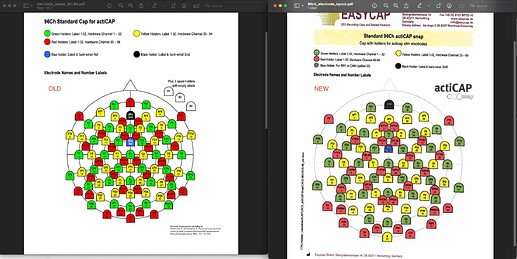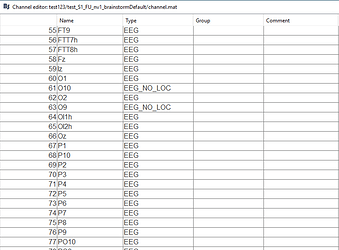[Originally posted in here]
We upgraded our BrainProducts/BrainVision system from the taller electrodes to the slim electrodes approximately a while ago (perhaps late 2021 or 2022?). Last week I found that there are slight differences in the old electrode layout (which Brainstorm seems to have) and the updated slim electrode layout. I've attached screenshots at the bottom to depict these differences.
How might this affect our use of the Brainstorm's version of the standard BrainProducts/BrainVision electrode file if we've been using the slim electrode layout for most of our ongoing study? Only the first few participants had the old electrode layout used, but most of those individuals had CapTrak data.
I tried to update one subject's electrode positions (that we obtained from the new system's vhdr file) with Brainstorm's default BrainProducts/BrainVision standard 97 channel cap and found that Brainstorm's channel file does not have a location for AFz, O9, or O10, evidenced by the channel file saying "EEG_NO_LOC".
Screenshot of channel file layouts:
As you can see, the main difference is the change of the Ground electrode. APz for older cap, and Fpz for the newer cap.
Signals are references to the same point FCz, so, there should not be changes in the waveforms.
- The older cap had an EEG electrode in Fpz, but the newer does not.
- The newer cap has an EEG electrode in AFz, but the newer does not.
As such, averages in the sensor space need to take that into account. A possible solution would be to discard those EEG electrodes.
Soon, we will release the EEG electrode positions cap for the snap (newest) actiCAP layout.
Regarding the O9 and O10, did you notice any change in their names? It seems both electrodes are present in both caps, thus it should be localized with the EEG positions from the old cap.
Raymundo,
How would I discard the electrodes? Would leaving them as EEG_NO_LOC in the channel file exclude them?
And if we did not want to exclude the Afz and/or Fpz, what could we do to include them if some subjects have GND as Fpz and others have GND at AFz?
Is it correct that the primary (or only?) issue in this situation is that some subjects will have data from Afz and others will have data from Fpz, and we are wondering how to compare the data concerning these two electrodes between the two subject groups (one group with Afz data, one group with Fpz data)?
O9 and O10: I don't notice any difference. Here are two screenshots:
Thank you,
Adam
You can change the type of the electrode to MISC (as miscellaneous).
That is right.


